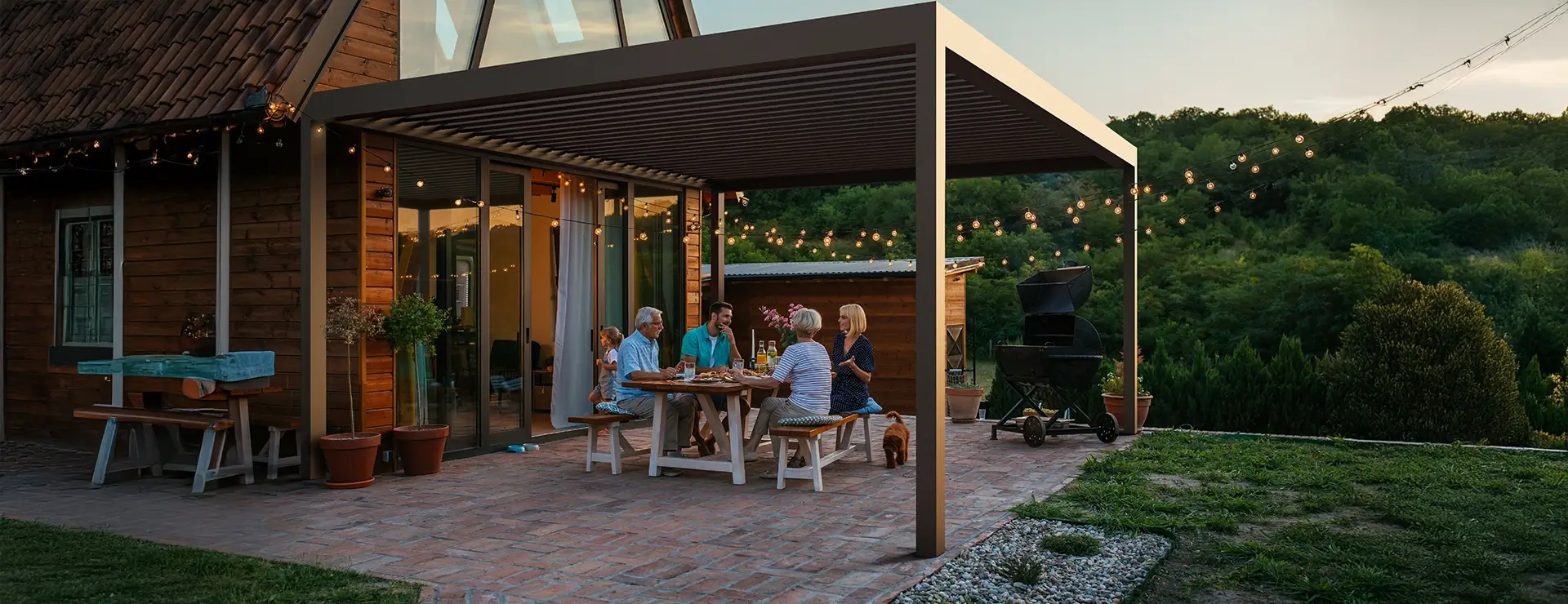

They are simple and yet incredibly practical structures that can be built in gardens and on terraces. They can protect you from the rain and sun, while their beauty catches the eye. They have posts with beams attached to them, forming a slatted structure on which any type of roofing can be placed.
A classic garden pergola is made of wood, where its roof is designed to allow climbing plants to grow up and over it. Alternatively, a pergola can be covered with:
When it comes to pergolas, we usually think about wooden ones, and yet structures made of metal, including aluminum, are becoming ever more popular. Both the designers as well as the property owners today are tending to select high-quality aluminum pergolas. Their most significant feature – apart from being much more durable than their wooden counterparts – is roofing made of movable slats. These slats have a function that allows you to control the angle of inclination. In this way, depending on your needs at any given moment, the roof can be set to closed, fully open or partially open.
Such structures have been used in gardens since the dawn of time. According to many historians, they were already known in ancient times. In all likelihood, they were created by ancient Egyptians, Greeks and Romans to shade courtyards and garden passages.
What is certain is that in the Middle Ages, pergolas were a common sight in areas surrounding palaces and monasteries. Pergolas have also been immensely popular during the dominance of modernism in architecture (for most of the 20th century), when they have been commonly used in Europe and the United States.
Throughout the centuries, garden pergolas have been made of various types of materials. Wood was used mainly in the beginning, but later people started building structures made of:
Due to the development of the materials and technology, today these landscaping elements can perfectly combine above-average durability with great functionality and modern design. An excellent example of this is the MB-OpenSky 140 terrace pergola, made of aluminum.
Its main advantages include:
Another important advantage of MB-OpenSky 140 is a roofing made of movable slats. Thanks to special gaskets, when the slats are closed, the roof is completely watertight, meaning that all rainwater is drained by a hidden gutter system. In addition, an electric mechanism controls the angle of inclination of the slats, meaning it can be controlled manually or remotely, using a remote control or a mobile app.
If you often spend your free time in your garden or on your terrace, consider adding a pergola to your property. A modern pergola gives you:
Are you looking for this type of product? Choose Aluprof! We provide modern terrace pergolas that feature roofing using movable slats. Made of extruded aluminum, they are characterized by extreme robustness. We also ensure that our products look good – the individual components fit together perfectly, allowing the creation of a uniform surface that is easy on the eye.
Why wait, order an aluminum pergola from the MB-OpenSky line today – either the 120 or 140 model. There are up to 12 colors available for you. If you want, you can also add sliding glass panels or screens.
Feel free to contact our experts – write to us, call us or visit an Aluprof showroom.
At Aluprof, we are continuously developing innovative solutions that blend cutting-edge technology with unique design. To cater to our customers’ expectations, we are introducing new products in the segment of aluminum doors. The latest additions to our range include the MB-Skyli...
Window walls are an architectural solution that has gained immense popularity in the United States, becoming a symbol of modern architecture. While it originated in the USA, other countries – including Poland – should definitely get to know it too. But what exactly are window w...
Modern construction increasingly relies on state-of-the art technologies and materials that combine aesthetics with functionality. These include aluminum façades. Being versatile and durable, they are very popular in both residential and commercial buildings. Let’s take a closer ...